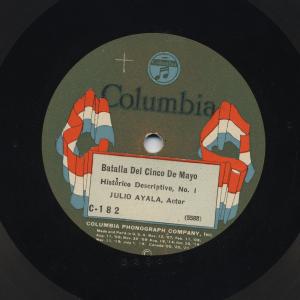the UCLA Chicano Studies Research Center,
the Arhoolie Foundation,
and the UCLA Digital Library
 Among the most fascinating recordings in the Frontera Collection are the staged re-enactments of historic events. In the era of 78 rpm discs, these historic accounts, with their sound effects and scripted dialog, gave people a sense of being present at momentous battles, revolutions or times. Even today, it’s not hard to imagine the appeal of recordings that bring to life distant happenings that, in those days, could only be talked about or read in newspapers. The recordings are mostly one-sided accounts filled with fanfare, hero worship and patriotic pomp and circumstance.
Among the most fascinating recordings in the Frontera Collection are the staged re-enactments of historic events. In the era of 78 rpm discs, these historic accounts, with their sound effects and scripted dialog, gave people a sense of being present at momentous battles, revolutions or times. Even today, it’s not hard to imagine the appeal of recordings that bring to life distant happenings that, in those days, could only be talked about or read in newspapers. The recordings are mostly one-sided accounts filled with fanfare, hero worship and patriotic pomp and circumstance.
On this Cinco de Mayo weekend, it’s fitting to spotlight a series of recordings that re-tell the historic Battle of Puebla, in which Mexican troops under the leadership of Ignacio Zaragoza defeated a superior French invasion force. The account of the battle, in the voice of narrator and creator Julio Ayala, is told in four parts on two 78 rpm discs released by Columbia. As is common with such historic re-creations on records, a special label was designed for the release, with a title box adorned on each side by banners in the colors of the Mexican flag.
The theatrical story-telling may sound stilted and over-the-top by today’s media-saturated standards. But it must have been exciting for listeners in a time before television made us instant witnesses to history. These records could have easily carried the caption, “Breaking News.”
In Part 1, we hear the clamorous ringing of cathedral bells calling soldiers to battle with the cry, “Muchahcos, a la victoria!” Then bugels and drums and the cheers of “Viva el General Zaragoza! Viva!” At the end of the side’s 2:53 playing time, the narrator says, “Sigue la segunda parte” (Continued in Part 2). On the flip side, Ayala echoes the battle action, blow by blow, with the general rousing his troops.
In Part 3 (a separate disc), we hear the crackling of gunfire and a narrator describing the action, almost like an announcer at ringside. Then, someone addresses General Miguel Negrete, another hero of that battle: “General Negrete, the French are upon us and we’ll die if we don’t defend ourselves. What shall we do?” That’s followed by the order to “head for higher ground.” The side closes with the proclamation of victory and cries of “Viva Mexico.” We also hear the dictation of a victory telegram to leaders in Mexico City: “Let’s see, Sr. Telegrafista. Put this down: Puebla, May 5, ’62, at 5:49 in the afternoon. Hon. Minister of War, the forces of the supreme government have draped themselves in glory … And I sign, Ignacio Zaragoza.”
Part 4 is devoted to festive orchestra pieces. We hear the joyful peal of church bells and more cries of “Viva.” Strangely, though, the small chorus of voices repeats the word, “Viva,” they sound lame and anemic. It smacks of the weak crowd choruses sometimes heard in the cartoon reenactments of Mr. Peabody’s Improbable History from The Rocky and Bullwinkle Show, to draw a contemporary comparison. In this old-style re-creation, you’d expect a little more oomph in the Vivas!
-AgustÍn Gurza
0 Comments
Stay informed on our latest news!
Add your comment